|
Safe to eat

By Nancy Bartosek
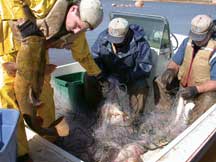 Fact: Every fish inevery Texas lake has some mercury contamination. Fact: Every fish inevery Texas lake has some mercury contamination.
Sound scary? Well, don't swear off fish just yet. While all the species we like to eat contain some mercury, most are safe. In fact, fish can be an essential part of a healthy, balanced diet.
Still, questions remain, and Ray Drenner, chair of the biology department, wants answers. He has drawn together graduate and undergraduate students as well as faculty to learn more about contamination in Texas lakes, of which little is known.
Fact: Eating mercury-laden fish can pose serious health risks, especially to the unborn.
"Mercury contamination of fish and its effects on human health, especially on the unborn, is one of the most pressing environmental issues facing America today," Drenner says. "Mercury is in our lakes and rivers and, therefore, in the fish we eat. And it's not going away soon."
So how bad is it?
Every year 50 tons of mercury are added to the toxic miasma.
This will only get worse if environmental regulations aren't strengthened.
Understanding how mercury affects the fish populations and
how to protect people from contamination is imperative.
A few select students have led the way with a series of initial projects.
Their work may change the way we choose what to eat
and one day set protocol used by governments and legislators
as they tackle this threat to public health.
Testing the waters
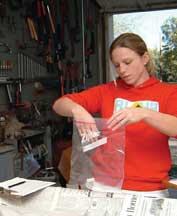 Davis '05 (MS) was on an odd sort of fishing expedition one sunny morning last fall. She was standing over four heavy coolers filled with day-old bass, gizzard shad and sunfish, but the catch this graduate student sought wouldn't end up on any dinner table. Davis '05 (MS) was on an odd sort of fishing expedition one sunny morning last fall. She was standing over four heavy coolers filled with day-old bass, gizzard shad and sunfish, but the catch this graduate student sought wouldn't end up on any dinner table.
Davis was after information. Data that would lead to a better understanding of mercury contamination in local lakes.
The fish that caused her nose to crinkle had been gathered from Lake Ray Hubbard the day before as part of the Texas Parks & Wildlife Department's fish population-monitoring responsibilities.
The converted garage where Davis and others worked is part of a bucolic cluster of small buildings belonging to the TPWD Inland Fisheries Division District. The wooded tract tucks between a branch of the Trinity River and a former federal hospital prison that once was part of Carswell Air Force Base in northwest Tarrant County.
Davis grabbed a net bag of the frosty, slimy catch and dumped it on a table covered with newspaper. She and research colleague Keri McNew '04 chatted amicably with two fisheries biologists as they worked.
The group measured and sorted the fish, diligently recording pertinent information. The biologists carefully removed the otoliths (ear bones) from each fish and dropped them into small plastic tubes. Like tree trunks, otoliths have rings that correspond to age. That information would later help Davis as she correlated age to length, then to mercury levels.
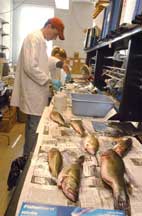 If you eat mercury-laden fish before or during a pregnancy, your baby is at risk for neurological damage. Young children with elevated mercury can experience learning difficulties, mental retardation and, some think, autism. Even if you're not pregnant, eating too much of the wrong type of fish can damage the heart, brain, lungs, kidneys and adrenal, pituitary and thyroid glands. If you eat mercury-laden fish before or during a pregnancy, your baby is at risk for neurological damage. Young children with elevated mercury can experience learning difficulties, mental retardation and, some think, autism. Even if you're not pregnant, eating too much of the wrong type of fish can damage the heart, brain, lungs, kidneys and adrenal, pituitary and thyroid glands.
We all have some mercury in our bodies. Old thermometers and "silver" dental fillings among the contributors, but coal-burning plants are the greatest offenders. But you don't breathe this poison, though, you ingest it through the fish you eat.
When companies burn mercury-laden coal (such as the kind found in the eastern U.S.), traces of mercury (Hg) waft into the atmosphere. Rain washes the mercury into bodies of water, where bacteria turn it into water-soluble methylmercury. The methylmercury is absorbed by small organisms known as plankton, which fish consume. These small planktivorous (plankton-eating) fish are then eaten by larger fish. The mercury keeps accumulating up the food chain until the largest fish end up with the highest levels. Then you have shark or king mackerel -- or the bass your friend just caught -- for dinner.
The fish Davis tagged and bagged that day were loaded back into the coolers and hauled to a small lab on the fourth floor of Winton-Scott, where students later removed two dorsal fillets from each before discarding the remains.
The fillets were labeled and stowed in one of four large freezers in the oddly shaped and overcrowded lab belonging to Ray Drenner, a boyish-looking limnologist with a quick smile.
Drenner has been collaborating with TPWD for 25 years on various projects, including studying water quality in lakes and the effects of fish on food chains.
While investigating environmental hot buttons for his popular Contemporary Issues in Biology class, Drenner's interest was piqued by a spate of papers in scientific journals on mercury contamination. He was pleased to discover that environmental science Professor Leo Newland also had an interest in the topic, so the two approached science and engineering Dean Mike McCracken about buying a sophisticated mercury analyzer. By spring 2004, Newland had a new $33,000 analyzer in his lab.
A grant from the TCU Research and Creative Activity Fund gave the two professors some research money to work with. Resources in hand, the two could begin testing contamination levels locally.
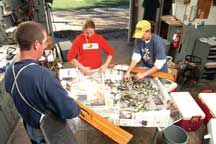 All they needed were a lot of fish. All they needed were a lot of fish.
Drenner turned to his TPWD colleagues, and by fall several TCU students were piggybacking on the fish collections with fisheries biologists.
"After the biologists get the information they need, they just throw the fish away," Drenner explained. "So this was ?great for us. We take the fish they collected, and use them for our analysis. In return we give them the data we collected."
Drenner's interest in mercury was contagious, and soon three of his graduate students were busy collecting and measuring fish. Matt Chumchal '01 (MS '03), who had moved on to the University of Oklahoma to pursue a Ph.D., was delighted to team once again with his former professor.
Bill McClain '05 (MS) and Davis both chose a focus within the field for their master's theses -- McClain on how mercury levels varied with species in a lake, and Davis on how contamination varied in largemouth bass between lakes within a region.
A large-scale project
The United States has 1,100 coal-burning power plants. Texas is home to 20, including the TXU Monticello plant near Mount Pleasant, which earned the dubious honor this spring of being named the worst mercury-emitting plant in North America. While TXU points out that the data used is two years old and that it no longer burns mercury-rich lignite, much damage has been done by all the plants in Texas and around the world.
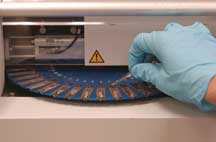 At Caddo Lake, which is downwind of Monticello and four other power plants, a fishing advisory has been in effect for several years. In all, mercury advisories have been issued for lakes in 33 Texas counties. All but three of those counties hug the eastern state line. Not surprisingly, most of the state's power plants line east Texas from north to south. At Caddo Lake, which is downwind of Monticello and four other power plants, a fishing advisory has been in effect for several years. In all, mercury advisories have been issued for lakes in 33 Texas counties. All but three of those counties hug the eastern state line. Not surprisingly, most of the state's power plants line east Texas from north to south.
Mercury in fish is of concern to two state agencies: the Texas Department of Health Services, which issues fishing advisories to protect human health; and the TPWD, which oversees the health of the game fishing industry.
Public health, of course, is the No. 1 concern. "But you also want to protect the fishing industry, which generates lots of conservation dollars," Chumchal noted. "So inaccurate advisories can have big implications."
Mercury testing is time-consuming and expensive for state agencies that are usually cash strapped. In Texas and many other states, two or three fish are usually collected from each lake and tested. If mercury levels are above the state advisory level (700 parts per billion in Texas), an advisory is issued. (The Environmental Protection Agency recently set its level at a more cautious 300 ppb, but each state is free to set its own standard.)
Chumchal's research indicates that states generally are working with inadequate information. He entered the data collected into a computer model that shows that small samples from a lake simply won't give good numbers. Test only three fish, for example, and you'll be wrong 18 percent of the time.
"But if you increase that to 20 to 30 fish, then you'll be right almost 100 percent of the time," he said.
Mercury rising
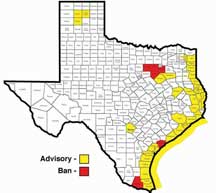 Analyzing mercury levels in fish according to EPA standards requires (besides a desensitized nose) a lot of patience. "I've had a few strange stares when I walk through the halls after working on the fish," Davis said, laughing about the odor that often follows her from the lab. But it's rewarding work. She understands that her research will become part of the global contamination database. Analyzing mercury levels in fish according to EPA standards requires (besides a desensitized nose) a lot of patience. "I've had a few strange stares when I walk through the halls after working on the fish," Davis said, laughing about the odor that often follows her from the lab. But it's rewarding work. She understands that her research will become part of the global contamination database.
Still, there is the monotonous part: Every sample must be processed according to specific methods proscribed by the EPA. The researcher must wear rubber gloves and wash knives in nitric acid, then rinse them in de-ionized water between each step.
First a small slice of each fillet -- 100-250 milligrams -- is excised, weighed and placed in a small "boat," 40 of which go into each run of the analyzer. The samples are then cremated at 850 degrees Fahrenheit, which evaporates the mercury for measurement. Each run takes about 2 1/2 hours.
More than 1,000 fish, gathered from 12 lakes, were sampled for the TCU studies. Collecting the fish took three months. Analyzing them took two more. More collections took place in the spring and more fish will be tested in coming as they chase intermediary answers to the bigger question: What are the factors in lakes and fish communities that predict mercury poisoning?
What have the researchers discovered so far?
-- Bigger (older) fish have higher concentrations of mercury.
-- Mercury contamination can vary from lake to lake, even lakes in close proximity.
-- A small sampling often results in inaccurate advisories.
Their recommendations:
-- Issue advisories based on fish length, not species, since only the largest fish typically are contaminated above safe levels.
-- Do not apply regional advisories based on samples from only a few lakes.
-- Increase sampling size to 20 fish per lake.
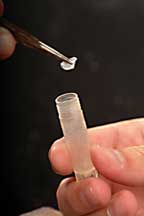 The students have already presented their findings to limnologists, aquatic ecologists and the Texas chapter of the American Fisheries Societies. More presentations are planned. The students have already presented their findings to limnologists, aquatic ecologists and the Texas chapter of the American Fisheries Societies. More presentations are planned.
And next year more students will ask more questions and test more fish.
The impact of the data being collecting is easy to minimize, the small fish in a big ocean scenario. But if the research is accepted by a top scientific journal, which is likely, then state and federal agencies could use it to set advisory standards. Which would be like the tartar sauce on a fish dinner, Chumchal said.
"It's been extremely satisfying to work on something that has applied significance," he said. "I get to use my knowledge of ecology and biology in a way that has important applied human and environmental health impacts."
Chumchal will continue to be involved on the team and says he'll likely stay in contaminants post-doc.
For McClain, an exciting part of the work has been figuring out the question, then finding a way to answer it.
"You really have to be an expert in an area even before you begin to ask appropriate questions," he said. "You have to be constantly learning."
By the time Davis and McClain concluded their thesis projects in the spring, Drenner was asking new questions. He read that in an isolated corner of Canada fish with high mercury levels have correspondingly high levels of other toxins, specifically PCBs and pesticides. And because the area is so remote, the toxins were probably airborne. Drenner believes he'll find that same situation closer to home, but his hypothesis about a similar "toxicant meatloaf" in Texas remains untested.
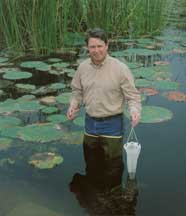 Once he and Newland do a bit of preliminary work, they'll enlist a new batch of curious students to help them find that answer, too. New papers will be written and new data will be published. Once he and Newland do a bit of preliminary work, they'll enlist a new batch of curious students to help them find that answer, too. New papers will be written and new data will be published.
Drenner downplays his contribution, although his students say he's not only their mentor, he's the driving force behind the research. He replies: "It's their project. They do all the work." He's just there to advise.
But in an unguarded moment, the man who prefers waders to wingtips admits with a grin why he loves the chase.
"Really, it's just a whole lot of fun."
Contact Drenner at r.drenner@tcu.edu.
Comment at tcumagazine@tcu.edu.

Web sites
Environmental Defense Network
(interactive site great for kids)
www.oceansalive.org
Environmental Protection Agency (EPA)
www.epa.gov.mercury
United Nations Environment Programme
www.chem.unep.ch/mercury/

Guidelines to reduce the risk from chemical contaminants in fish
Fish and shellfish are an important part of a healthy diet. They're high in protein and other essential nutrients, low in saturated fat, and contain omega-3 fatty acids. A balanced diet that includes a variety of fish and shellfish can contribute to heart health and children's proper growth and development. Women and young children in particular should include fish or shellfish in their diets due to the many nutritional benefits.
However, nearly all fish and shellfish contain traces of mercury. For most people, the mercury risk from eating fish and shellfish is not a health concern, but the risks accelerate for the unborn.
The Food and Drug Administration and the Environmental Protection Agency advise women who may become pregnant, pregnant women, nursing mothers and young children to avoid some types of fish and to eat fish and shellfish that are lower in mercury. Specific recommendations:
-- Do not eat shark, swordfish, king mackerel or tilefish because they contain high levels of mercury.
-- Eat up to 12 ounces (two average meals) a week of a variety of fish and shellfish that are lower in mercury.
-- Five of the most commonly eaten fish that are low in mercury are shrimp, canned light tuna, salmon, pollock and catfish. Another commonly eaten fish, albacore ("white") tuna, has more mercury than canned light tuna.
-- When choosing the two meals of fish and shellfish, limit albacore consumption to 6 ounces (one average meal) per week.
-- Check local advisories about the safety of fish caught in local lakes, rivers and coastal areas. If no advice is available, eat up to 6 ounces per week of fish caught locally, but don't consume any other fish during that week.
Source: www.epa.gov/mercury/
|



